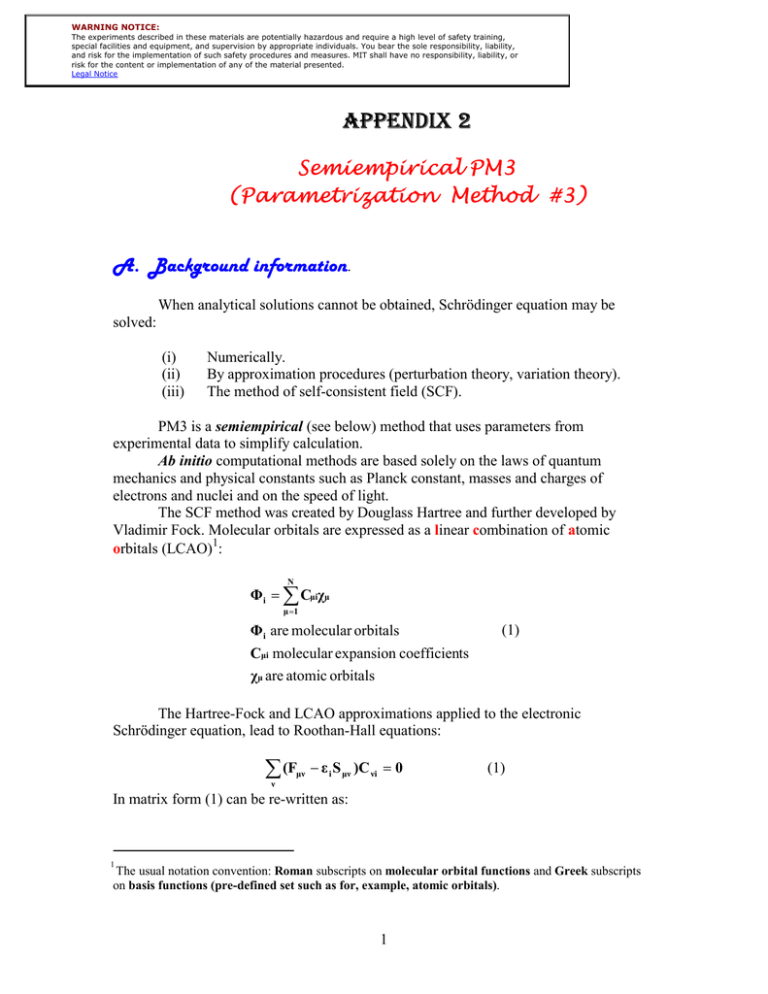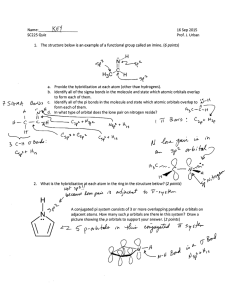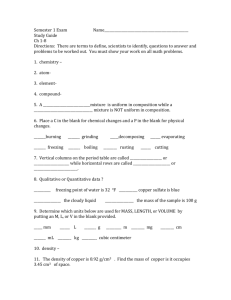Document 13496587
advertisement

WARNING NOTICE: The experiments described in these materials are potentially hazardous and require a high level of safety training, special facilities and equipment, and supervision by appropriate individuals. You bear the sole responsibility, liability, and risk for the implementation of such safety procedures and measures. MIT shall have no responsibility, liability, or risk for the content or implementation of any of the material presented. Legal Notice APPENDIX 2 Semiempirical PM3 (Parametrization Method #3) A. Background information. When analytical solutions cannot be obtained, Schrödinger equation may be solved: (i) (ii) (iii) Numerically. By approximation procedures (perturbation theory, variation theory). The method of self-consistent field (SCF). PM3 is a semiempirical (see below) method that uses parameters from experimental data to simplify calculation. Ab initio computational methods are based solely on the laws of quantum mechanics and physical constants such as Planck constant, masses and charges of electrons and nuclei and on the speed of light. The SCF method was created by Douglass Hartree and further developed by Vladimir Fock. Molecular orbitals are expressed as a linear combination of atomic orbitals (LCAO)1: N Φ i = å Cµiχµ µ =1 Φ i are molecular orbitals (1) Cµi molecular expansion coefficients χµ are atomic orbitals The Hartree-Fock and LCAO approximations applied to the electronic Schrödinger equation, lead to Roothan-Hall equations: å (F µν - ε i S µν )C νi = 0 (1) ν In matrix form (1) can be re-written as: 1 The usual notation convention: Roman subscripts on molecular orbital functions and Greek subscripts on basis functions (pre-defined set such as for, example, atomic orbitals). 1 FC = SCε (2) F is the Fock matrix (analogous to Hamiltonian in the Schrödinger equation) For closed systems2 , Fock matrix elements are: N N 1 Fµν = H core + Pλσ [(mn|ls)- (ml|ns)] åå µν 2 λ =1 σ =1 (3) where: · H core is a matrix representing the energy of a single electron in the field of the µν core. In semiempirical methods the core is defined as the nuclei and nonvalence electrons. The valence electrons are assumed to move in the 1 core potential field of the core. H core χ ν (1) ; H core (1) = - Ñ2µν = χ µ (1) H 2 M ZA ; ZA is the atomic number of atom A. å A =1 r1A · Pλσ is the density matrix. The molecular expansion coefficients are summed only over the double occupied molecular orbitals (number 2 in front of summation): occupied MOs * λi i =1 Pλσ = 2 åC Cσi (4) · The quantities (ms|ln) are two-electron repulsion integrals (representing the coulombic interaction between the cloud of electron 1 and cloud of electron 2) 1 òò χ µ (1)χ σ (1) r12 χ λ (2)χ ν (2)dv · The quantities (ml|sn) are two-electron exchange integrals. It represents the correction required for the Coulomb integral to take into effect the spin correlation. For two electrons with the same spin, the true average repulsion energy will be less than the value of Coulomb integral, because such electrons 1 avoid each other: òò χ µ (1)χ σ (2) χ λ (1)χ ν (2)dv r12 S is the overlap matrix; its elements are given by Smn= χ µ (1) χ ν (1) energy. e is a diagonal matrix of orbital energies with elements ei, the one-electron orbital The Roothan-Hall equations are not linear. The Fock matrix depends on the molecular orbital coefficients, through the density matrix. Its solution requires an iterative process. To begin the calculation, we must pick a preliminary set of wave functions to calculate the Fock operator, for example, wave functions from extended 2 All electrons are paired. 2 Hückel type methods. In the first cycle a new set of orbitals are generated which become the the starting orbitals for the second cycle. The cycle is repeated until the set of orbitals going through the cycle are returned unchanged. The orbitals are then self-consistent, hence the acronym SCF. The Unrestricted Hartree-Fock method (UHF) allows more freedom because it permits the spatial form of the orbital to depend upon whether the electron has an a or a b spin. B. PM3 method. 3 The two electron repulsion integrals (ms|ln) and (ml|sn) cause most of the trouble. These integrals are particularly difficult to evaluate if the atomic functions cm, etc. are centered on different atoms. The central approximation to reduce the overall computation is to not permit the overlap of atomic orbitals residing on different atomic centers, for example, by a assuming (ms|ln)=dmsdln(mm|ll). Here dms and dln (Kronecker’s delta) equal 1 when the subscripts are equal; otherwise they are zero. Consequently, all three- and four-centers integrals are ignored, as well as two- and onecenter integrals where different atomic orbitals are involved in either of two electrons. In other words, the central approximation to the reduce overall computation is to presume that atomic orbitals residing on different atomic centers do not overlap: òχ µ χ σ dv = 0 . A very popular semiempirical, MNDO (modified neglect of diatomic overlap) method was published in 1977 by Dewar and Thiel.4 The second generation of MNDO has been termed AM1 (Austin method #1)5 , while the third generation MNDO-PM3, or in short PM3 (parametric method 3). PM3 includes atoms with d orbitals. Parameters for transition metals are based on reproducing known geometries. C. Heat of formation calculation. (You’ll use this in 5.32) The heat of formation of any compound from its elements in their standard state is obtained by adding to the electronic plus nuclear energy, the calculated energy of formation of the gaseous atom A from its ion, (Eel(A)) and the experimental heat of formation for atom A, DHf(A): DH f = E ee + E nr + å E el (A) + å DH f (A) A A Calculation of the heat of formation: the case of the CH2: · Atomization energy is: Eatom=- -EtotCH2 + EC + 2EH = 151.586368-120.5006062*11.906276=7.27321 eV=167.72 kcal mol-1. 3 4 5 Stewart, J. J. P., J. Computer-Aided Mol. Design 1990, 4, 1. Dewar, M. J.; Thiel, W. J. Am. Chem. Soc. 1977, 99, 4999. Dewar, M. J.; Zoebisch, E. G.; Healy, E. F.; Stewart, J. J. P. J. Am. Chem. Soc. 1985, 107, 3902. 3 · Heat of formation: DH°f(C) +2 * DH°f(H))-Eatom = 170.89 + 104.20 – 167.72 = 107.37 kcal mol-1 4 D. Solutions of the self-consistent equations: Read the intial geometry Initial guess at Pmn Compute Fock matrix Solve matrix equation Form density matrix Calculate energy No Energy and/or density matrix has converged? Yes Population analysis Finished 5





